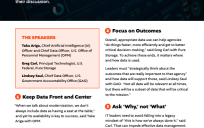For my final blog post to complete my submission for this series, I would like to talk about the most important part of the analytics process within an urban environment: impacting the resident.
To recap, we started with identifying processes to ensure the city is managing data as a quality asset. We talked about making sure that we are identifying and properly answering a real city question. Then we talked about the process of selecting a robust solution for the problem. Now we are talking about how to deploy such a solution to the resident in a city so it maximizes impact to whatever problem will be taken on.
There is a reason why I have not included a chart with any of the previous blog posts I have submitted. It’s because to show a linear flow in any way would be misleading. Yes, I do think there is a definitive start to an analytics problem in a city, but I don’t believe there is a definitive stop, or an end to many, if not most, urban analytics projects.
Have you ever heard a mayor or commissioner state that “We have solved such and such problem, therefore this city will never need to address this problem ever again?” Of course you haven’t heard this. That is why when you look at the urban analytics ecosystem diagram that I shared in my very first blog, it is portrayed as a loop that feeds back into itself.
The more we do, the more the city changes. That means the more we have to shift in order to respond to these changing dynamics, which requires more data-driven work. This is why we don’t just focus on the efficiency of the project; we focus on the outcomes and the impact on the residents. This is the only measure of impact that matters.
We used to have a saying at the New York City Mayor’s Office for Data Analytics (MODA), “We don’t write one line of code unless we know that our work is being designed to impact.” We did not do analytics for analytics sake, nor did we do it just to react to questions. We did it to drive impact for New Yorkers.
This is important because starting the project with your ultimate goal in mind (the impact for your residents/key stakeholder) forces you and your analytics team to keep them in mind throughout the full and complete analytics process. But what also happens is it ensures that you are considering these key elements across the lifecycle of your project:
- What success is for a resident;
- Privacy concerns;
- Transparency;
- Equity;
- Resident feedback loop.
I was recently at an event and sat on a panel. I was asked a very serious question: “Why should residents of any city have faith that the work you and others say you are doing to make cities better is real?”
The person asking the question was concerned with all of the “smart city” talk, and wasn’t clear that any of this conversation about tech, pithy slogans and platitudes had the focus or the wellbeing of the resident in mind. I gave a brief, but, I hope, helpful response. Let me take this opportunity to use the key elements mentioned above to give a more robust response to such a great question.
First, we must partner with residents, agencies and other city leadership to understand exactly what the problem is we are looking to solve, whom it is intended to impact and how to ensure it moves the needle in the right direction in the fashion that is expected by all stakeholders. Success for the agency, success for the resident and success of the execution of an urban analytics algorithm should all be calibrated in such a way that we are all working towards the same goal.
The work that is done should always consider data usage (should we use this data?); data access (who should be allowed access and how?); data sharing (how do we share the data, and with whom?); and data retention (how is this information managed over time?) Essentially, when handling data and the privacy of residents we should first ensure that we “do no harm.”
The last three key elements: transparency, equity and resident feedback often times work hand in hand. We cannot hope to execute on the promise of equity without getting feedback and input from the people of the community. The only way to properly do that is be as transparent about the analytics work as humanly possible.
In conclusion, we have only scratched the surface when realizing the potential of data science and analytics to impact the lives of people living in cities and counties across the world. But we are now realizing that the promise of this capability is rife with complications and challenges.
It is a long road to where we need to be, and this road must be traveled with private sector, academia, non-profits, government leadership and residents of our cities all hand in hand. This is the only way that urban analytics can have the impact that we need and expect it to have in our cities.
To get up to full speed on this analytics series, check out:
Analytics in Motion Part 1: Data Drills for a More Responsive City
Analytics in Motion Part 2: Executable Analytics Solution
Analytics in Motion Part 3: Developing the Analytics Solution
Amen Ra Mashariki is part of the GovLoop Featured Contributor program, where we feature articles by government voices from all across the country (and world!). To see more Featured Contributor posts, click here.





Leave a Reply
You must be logged in to post a comment.